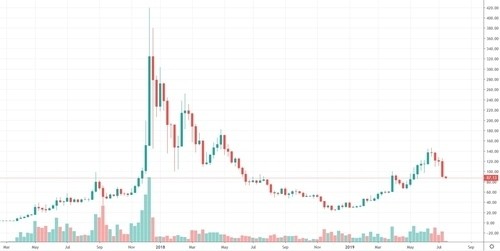What is Litecoin (LTC)? Simply stated, it’s a cryptocurrency, much like Bitcoin (BTC). For years now, Litecoin has marketed itself as “silver to Bitcoin’s gold,” which looks at both coins as scarce monetary assets which cost money to mine.

Like silver to gold, LTC is less valuable than BTC. At the time of writing, the former’s price is about $100 whereas the latter is currently worth about $10,500. This price ratio of 1:100 also fits, more or less, for the current price of silver ($15) against that of gold ($1415). What accounts for the disparity? One reason that the silver and Litecoin price are both lower than their counterparts’ is that these assets are both far more abundant. Whereas Bitcoin’s supply maxes at 21 million BTC, Litecoin’s issuance limit is 4 times bigger, at 84 million LTC.
Another reason for the price disparity is that Bitcoin, like gold, enjoys wider acceptance as money and is seen as a superior store of value. Litecoin, with its lower price, faster blocks, and lower transaction fees, is better suited to making small, quick purchases. Again, this is similar to how gold and silver were used under the bimetallic monetary standard. Specifically, gold was used like modern large-denomination bills, with silver used more like coins, for making a change or paying for inexpensive items or services.
Speaking of price ratios, one interesting fact which emerges from history is that between 323 BC and around 1900, the ratio between silver and gold was between 12 and 15 to 1. So what is Litecoin’s highest ratio to Bitcoin? If you take a similar look at the two cryptocurrencies, in late 2013, LTC reached a high of 0.048 BTC, or a ratio of close to 1:50. This suggests that, like silver to gold, the Litecoin price has the potential to appreciate greatly relative to Bitcoin. Those looking to speculate on a return to a higher relative valuation for LTC might choose to buy Litecoin.

Weekly LTC / BTC price since mid-2013, chart courtesy of TradingView.
Litecoin’s History
Litecoin was launched in October of 2011, making it the oldest major altcoin. As a result, it has a well-established economy and a large user base, relative to most altcoins. It also enjoys a lot of support on exchanges—as well as the darknet, where it’s probably the most popular cryptocurrency after Bitcoin. Soon after its release, the coin began to catch on among former Bitcoin GPU miners, who had enjoyed and profited from mining Bitcoin with their graphics cards.
It was created by Charlie Lee, a former Chief Technical Officer at Coinbase and a Google employee. Charlie is also the brother of Bobby Lee, who was the CEO of Hong Kong-based exchange, BTCC, which had the distinction of being the world’s second-largest exchange by volume in late 2014.
Charlie Lee left Coinbase in mid-2017 to focus on Litecoin full-time. In December of 2017, Charlie announced that he had sold the bulk of his LTC, to avoid any financial conflicts of interest in his role as a crypto expert, developer, and managing director of the Litecoin Foundation. As a regular commentator on the state of cryptocurrency on social media, the “Magical Crypto Friends” show, and at various conferences, Charlie wanted to distance his statements from any perceived attempt to influence the Litecoin price.
The Litecoin Foundation is a non-profit organization dedicated to promoting and developing LTC. It employs two full-time developers and is supported by numerous advisors, contributors, ambassadors, and other volunteers.

Charlie Lee, also known as “Satoshi Lite.”
How Litecoin Works
Litecoin’s codebase was forked from Bitcoin, with only a few significant changes made, and its code development tends to mirror that of BTC, with upgrades, patches, and optimization of BTC code usually ported across to it pretty rapidly. For example, Litecoin supports SegWit and the Lightning Network, and intends to include future Bitcoin upgrades, such as Schnorr Signatures and Confidential Transactions. Among the differences between it and Bitcoin are:
-
It has a maximum supply of 84 million LTC, versus Bitcoin’s 21 million. About 62 million LTC have already been mined, with the number of coins created with each new block found halving every four years.
-
Its block times are about 4 times as fast as Bitcoin’s, with a block found on average every 2.5 minutes.
-
It uses a different mining algorithm: scrypt (“ess-crypt”), which means Litecoin mining requires different hardware.
Litecoin contains many familiar elements from other Proof of Work (mineable) cryptocurrencies, like Bitcoin or Ethereum, such as:
-
Pseudonymous addresses (which begin with either an “L,” “M” / “3,” or sometimes “ltc1”) to receive payments
-
A blockchain which records all transactions between all addresses
-
Miners who perform computational work to enter new transactions into the blockchain and are rewarded with LTC whenever they successfully record a new block of transactions
-
Peer-to-peer transactions across a decentralized, censorship-resistant network
-
An open-source development process
If you want to buy Litecoin from Coinmama, the first thing you’ll need is a reliable wallet with which to receive your LTC. We would recommend only open source and trusted wallets, as featured on the coin’s official site’s “Download” section. Obscure or untested crypto wallet downloads from mobile app stores or websites have been known to contain coin-stealing malware, so be extremely cautious with those. We also have more tips on how to keep your investment safe here.
Vetted wallets include:
-
Litecoin Core (Full PC Wallet)
This wallet is available for Windows, Mac, and Linux. This is a full wallet, very similar to the Bitcoin Core reference client. As a full wallet, Litecoin Core will allow you to run a full node which supports the network. However, it will take time to sync up when you first run it or if you haven’t run it for a long time. It will also require more hard drive space, as it stores the full LTC blockchain (currently about 25 gigabytes), unless set to only store a portion via the “pruning” option.
-
Loaf Wallet (Mobile Wallet)
Loaf wallet (it holds your “bread”) is available for Android and iOS. This is a light wallet, which does not store the Litecoin blockchain but rather queries trusted full wallets which do store it. This means that Loafwallet consumes very little of your mobile device’s resources. Remember to back up your seed phrase in case your device is lost or damaged.
-
Electrum Litecoin (Light PC Wallet)
This is a fork of the Electrum light wallet originally created for Bitcoin. Similar to Loaf Wallet, it does not require you to store the entire Litecoin blockchain. However, it’s available for desktop or laptop systems running Windows, Mac, or Linux operating systems.
-
Hardware Wallets
If you plan to store a significant amount of LTC, then we’d recommend using a hardware wallet to do so. These devices generate and store your coins on a separate USB device, designed to keep your private key safe from hackers and thieves. Just as you wouldn’t buy a ton of silver then leave it out on your front lawn, don’t buy Litecoin then leave it in an exchange account or software wallet without a secure password and private key backup.
The Litecoin Price
In mid-2019, the LTC price mirrored that of other cryptocurrencies and regained the 3 digit US Dollar mark, just as Bitcoin was getting back to 5 digits. Its all-time high of $347 was reached around the same time that most cryptocurrencies peaked, in December of 2017.

Litecoin to USD historical price chart, courtesy of TradingView.
Thought at the time of writing, LTC is worth about $87, it’s hard to say where the Litecoin price will head next. However, if you believe it will recover and resume its upward climb, then the current dip would seem like an opportune moment to buy Litecoin.



